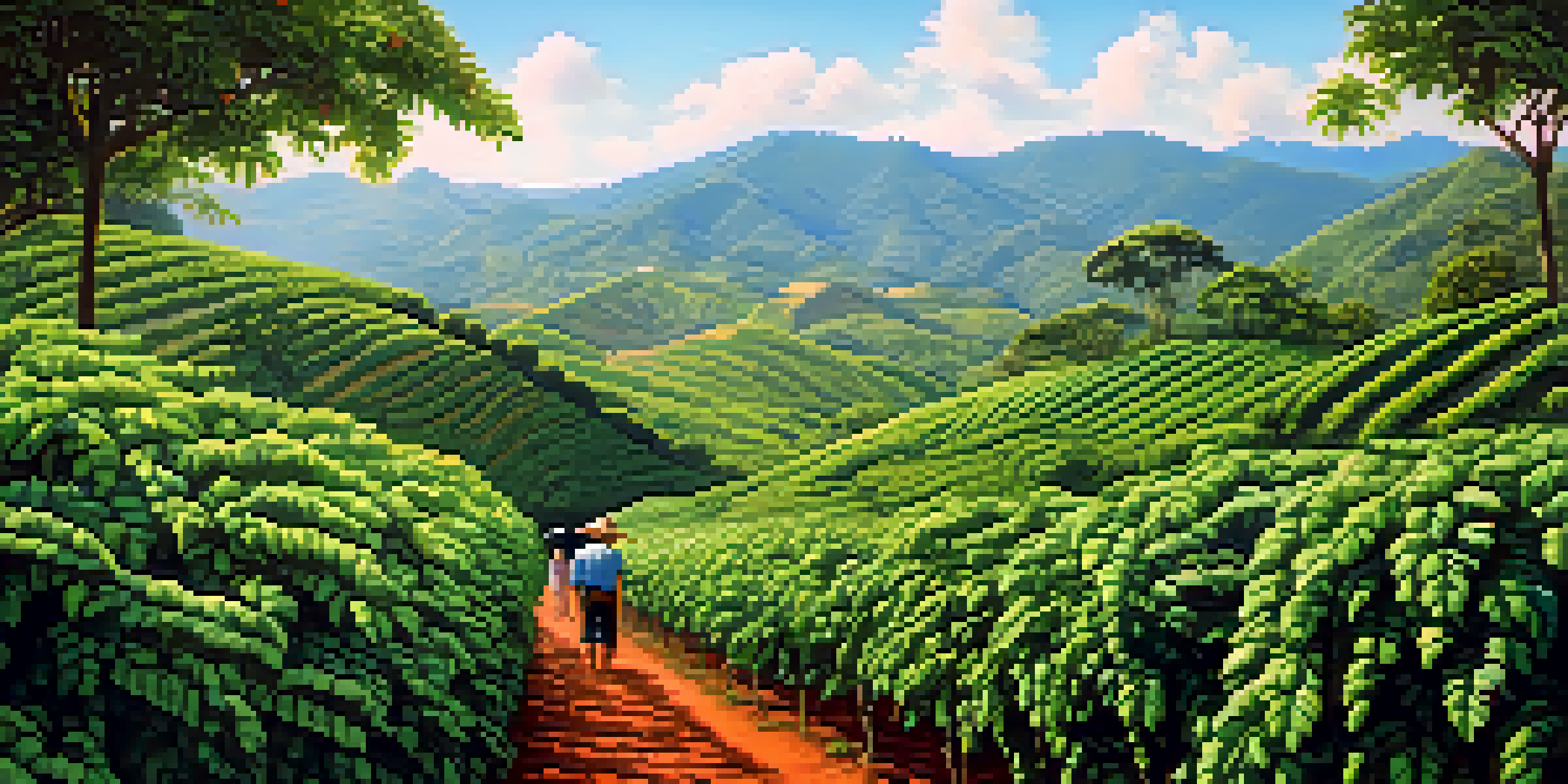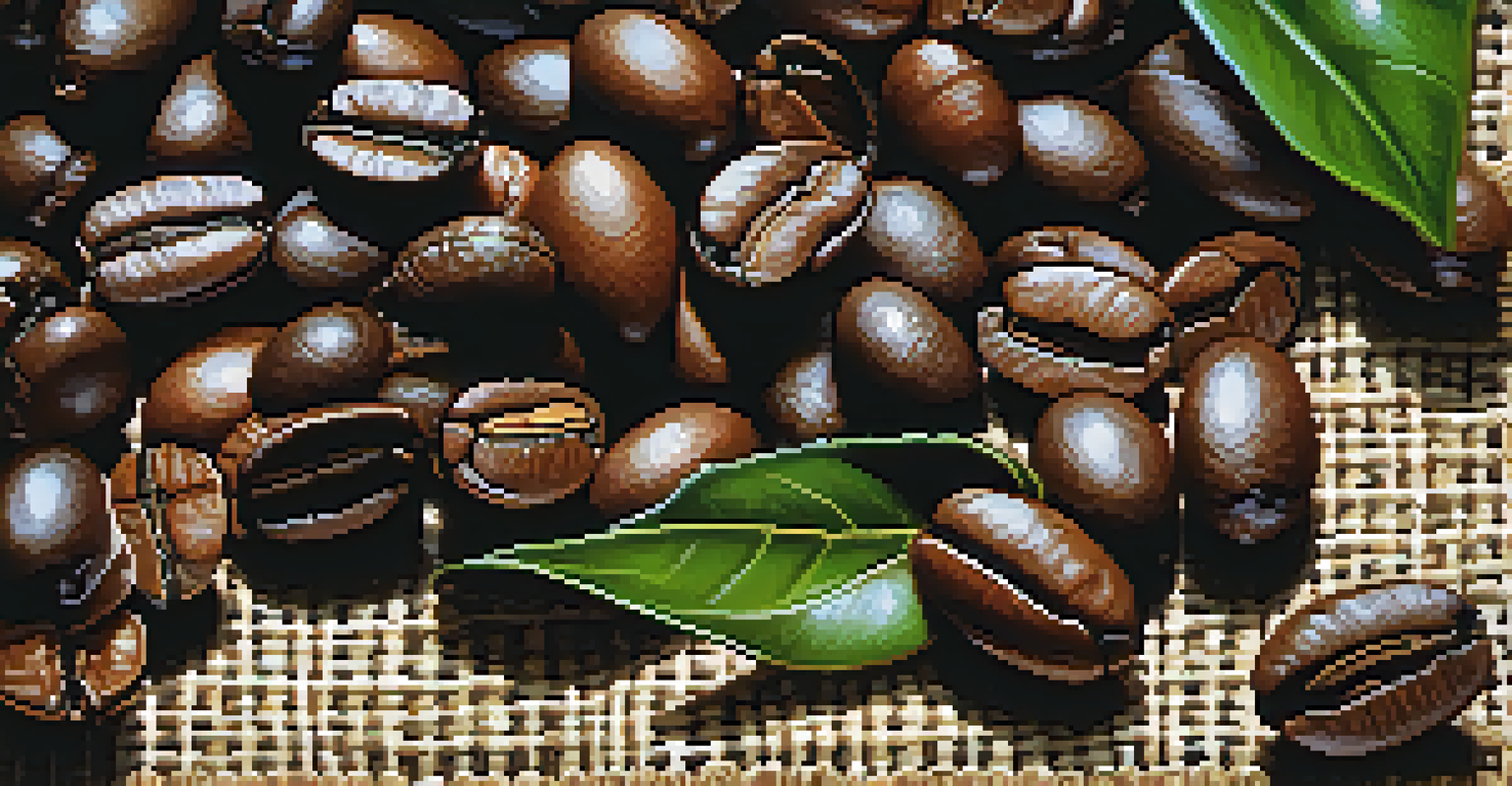Savoring the Flavors: Unique Varieties of Brazilian Coffee

Brazil: A Coffee Lover's Paradise with Diverse Varieties
Brazil is the largest coffee producer in the world, and for good reason. With its diverse climate and rich soil, the country fosters a variety of coffee beans that boast unique flavors. From the lush mountains of Minas Gerais to the sunny plains of São Paulo, each region contributes its own character to Brazilian coffee.
Coffee is a language in itself.
One of the fascinating aspects of Brazilian coffee is its ability to reflect the terroir, or environmental factors, that influence its growth. This means that coffee from one region can taste vastly different from that of another, much like how wines differ from various vineyards. You'll find everything from nutty and chocolatey notes to fruity or floral undertones.
So, whether you’re a casual drinker or a dedicated coffee connoisseur, exploring Brazilian coffee is like embarking on a flavorful journey, inviting you to savor each sip as you discover the rich tapestry of tastes this country has to offer.
Arabica vs. Robusta: The Main Varieties of Brazilian Coffee
When we think of coffee, two main varieties come to mind: Arabica and Robusta. In Brazil, Arabica is the star of the show, accounting for about 75% of the coffee produced. Known for its smooth, complex flavors, Arabica beans often have a sweetness that makes them highly sought after by coffee lovers worldwide.

On the other hand, Robusta beans are known for their bold flavor and higher caffeine content, making them a popular choice for espresso blends. While they make up a smaller portion of Brazilian coffee production, Robusta can offer a distinct earthy taste that some coffee enthusiasts appreciate.
Brazil's Coffee Diversity Shines
Brazil's unique climate and rich soil produce a stunning variety of coffee beans, each with distinct flavors reflecting their regions.
Understanding the differences between these two varieties can enhance your coffee experience. Whether you prefer the gentle embrace of Arabica or the punch of Robusta, Brazil has something for everyone to enjoy.
Exploring the Flavor Profiles of Brazilian Coffee Regions
Brazil is divided into several coffee-growing regions, each with unique characteristics that influence flavor profiles. For instance, coffee from the Minas Gerais region is often celebrated for its sweet, chocolatey notes, making it a favorite among those who enjoy a smooth cup of joe. This region benefits from high altitudes and varying microclimates, which contribute to the complexity of its beans.
The best coffee in the world is the one you drink with your friends.
In contrast, the São Paulo region offers coffee with a more vibrant acidity and fruity undertones, thanks to its warmer climate and fertile soil. This diversity allows coffee drinkers to explore various flavors from the same country, making each cup a new adventure.
By savoring coffee from different regions, you can discover how geography and climate shape the taste of your beverage. It’s similar to how a single grape variety can yield different wines depending on where it’s grown, inviting coffee lovers to appreciate the nuances of Brazilian coffee.
The Role of Processing in Shaping Coffee's Flavor
Processing methods play a critical role in determining the flavor of Brazilian coffee. The two primary methods used are the natural process and the washed process. In the natural process, coffee cherries are dried in the sun before the beans are extracted, which often results in fruity, wine-like flavors.
On the other hand, the washed process involves removing the cherry's pulp before fermentation, leading to a cleaner and brighter taste. This method can highlight the coffee's inherent acidity and floral notes, providing a completely different experience for the drinker.
Arabica Dominates Brazilian Coffee
Arabica beans make up about 75% of Brazil's coffee production, known for their smooth flavors, while Robusta offers a bolder alternative.
Understanding these processing methods can deepen your appreciation for the complexities of Brazilian coffee. The next time you sip your brew, consider the journey it took from cherry to cup and how processing has shaped its unique flavor.
Sustainability: The Future of Brazilian Coffee Production
Sustainability is becoming an increasingly important topic in the coffee industry, and Brazil is no exception. Many Brazilian coffee farmers are adopting eco-friendly practices to ensure that their coffee production is both environmentally and socially responsible. This includes initiatives such as shade-grown coffee, which not only supports biodiversity but also enhances flavor.
Additionally, fair trade practices are gaining momentum, allowing farmers to receive fair compensation for their hard work. This means that when you choose Brazilian coffee, you're not just enjoying a delicious beverage; you're also supporting ethical practices that benefit the farmers and their communities.
As consumers become more conscious of their choices, the future of Brazilian coffee looks promising. By prioritizing sustainability, Brazil is ensuring that its rich coffee culture continues for generations to come.
Brewing Methods to Enjoy Brazilian Coffee at Home
Brewing Brazilian coffee at home can be a delightful experience, especially when you know the right methods to bring out its unique flavors. Whether you prefer a classic drip coffee maker, a French press, or a pour-over, each method can highlight different taste profiles. For instance, a pour-over can emphasize the coffee’s acidity and floral notes, while a French press lends a richer body to the brew.
Experimenting with grind size, water temperature, and brew time can also help you discover the best way to enjoy your Brazilian coffee. Remember, coffee is a personal experience, and what works for one person might not work for another.
Sustainability Shapes Coffee Future
Brazilian coffee farmers are increasingly focusing on eco-friendly practices and fair trade to ensure sustainable production and ethical practices.
By exploring various brewing techniques, you can transform your morning ritual into a gourmet experience. So, grab your favorite Brazilian coffee, and get ready to savor the flavors right at home!
Pairing Brazilian Coffee: Elevate Your Tasting Experience
Pairing food with coffee can elevate your tasting experience, and Brazilian coffee is no exception. The rich, chocolatey notes of Minas Gerais coffee go perfectly with a slice of dark chocolate cake, creating a delightful harmony of flavors. The sweetness of the coffee complements the dessert, making each bite and sip a match made in heaven.
On the other hand, coffee from São Paulo, with its fruity undertones, pairs beautifully with breakfast items like croissants or fruit tarts. The bright acidity of the coffee enhances the freshness of the pastries, creating a delicious start to your day.

Don't be afraid to get creative with your pairings! Experimenting with different foods can lead to exciting discoveries and deepen your appreciation for the flavors of Brazilian coffee. It's all about enjoying the moment and savoring every sip.